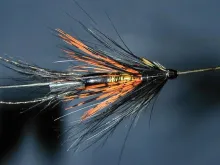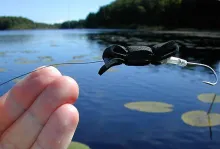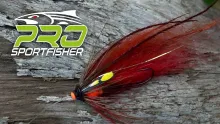Two seemingly unrelated events led tube fly tyer par excellence Bob Kenly to this method of tying and to discover a coloring system that I have never tried before: dyed Lady Amherst tail feathers and a note requesting something different to be thrown in the water for salmon in New Foundland.
Two seemingly unrelated events led me to this method of tying and to discover a coloring system that I have never tried before.
The first was a package from Stuart Anderson (Canadian Tube Fly Company) with dyed Lady Amherst tail feathers and a note saying,"see what you can do with this".
The second event, an e-mail from Hans van Klinken telling me that he was headed to Newfoundland in June for salmon and wondered if I had something different he could throw in the water. He had tied all the streamers to last a lifetime and then some so that option was out so I figured that a few patterns I was doing for people in Northern Ireland and Scotland just might be the ticket.
My first thought was a Black Shrimp from Scotland. Another option would have to probably be the Frances which seemed to be a very popular salmon fly.
The Black Shrimp body is divided into two sections, the forward yellow, the aft black with orange hackle between the two sections. The idea of using some of this yellow Lady Amherst tail as the yellow body section seemed like a good idea since I've never seen it done before. I was going to cover the body with epoxy anyway so the problem of fragility would be easily solved (in truth I cover everything with epoxy). I liked the result, for me a whole new dimension in color, at least in my eyes. What struck me most was the complete randomness of the two colors, no two flies would look the same, almost as in nature.
Tying a fly with Amherst tail
In this case I'll tie a Frances with orange Amherst tail feathers but I'm sure some people will come up with more and probably better ideas. Since I tie on tubes exclusively I'll tie on a plastic tube but there is nothing to say you can't use this method on a hook.
What you are going to need
Lady Amherst tail (obviously) in the color of your choice. Not all tail is the same, you'll want a section with the longest flue as possible (the best flue comes from the tail section closest to the bird's body)
Epoxy, both fast and slow drying. My choice is Devcon 5-minute and Devcon 2-Ton. The 5-minute stuff is to shape the body and the 2-Ton is the final coat to protect and strengthen the body.
Clear nylon sewing thread, completely disappears under epoxy but I have used normal colored thread in a pinch to fill a gap or two. Once the epoxy is applied you can't tell the difference as long as the thread and feathers are reasonably close in color.
Of course tube, hair, hackle etc for the fly.
Aluminum foil to mix the epoxy on.
Finally a rotary vise (a got to have when working with epoxy).
Toothpicks to mix epoxy and dab on the fly.
The Actual Tying Sequence
In this case part of the body will be directly on part of the hook keeper so I tie on the keeper first and then tie in the flash strands followed by the four hackle stems (antennas) and finally the hair in that order.
Taking three or four strands of the tail feather I tie them together where I an going to start the body. When you cut off the flues from the quill try to use the longest pieces as possible and for a more dramatic result cut pieces that are adjacent to each other (I have tried using pieces from different parts of the feather but the black areas seemed too small for my taste, nothing says you can't do it if you want too, I've even mixed different colors of flues just as a "what if" with so-so results). Carefully wind the feather pieces together around the tube (or hook) till you reach the end of the flues, tie off with the thread. If it looks lumpy or messy don't sweat it. Don't have enough, no problem, tie in some more and keep winding till you think you have enough for the body.
Some Things To Remember
First and foremost you are not going shape the body with the feathers, that comes from the first coat of epoxy. All is needed is the get the tube or hook covered the length of what you want colored. If you want to add ribbing go ahead before you tie in the first group of feathers but wind the ribbing in the opposite direction that you wind the feathers ( I've used ribbing on some of these flies but feel ribbing is a waste of time, if a fly needs flash that badly I'll add some sparkles to the final coat of epoxy, besides the feathers seem to have a segmented effect anyway). These feathers can be pretty fragile and easily cut with the nylon thread I use to tie with, be gentle with this stuff.
Now is the time we get into the first coat of epoxy. Take a good piece of aluminum foil and fold it in half with the dull side up (for some reason the bubbles in the epoxy are easier to see than with the shinny side, no clue why). Mix some of the 5-minute epoxy on the foil and spread it out so the bubbles have less fluid to dissipate through. In the mixture there will some epoxy with no bubbles and some with bubbles, use the epoxy with no or very few bubbles (remember the epoxy is already setting up so don't take forever to start using it). Start building up the body with the epoxy while turning the vise so the epoxy won't sag, once you think you have the body built up keep turning the vise till the epoxy is set up. DON'T TOUCH THE EPOXY WITH YOUR FINGERS TO SEE IF IT'S DRY ENOUGH TO STOP TURNING.
How I time this process is to keep mixing the epoxy left over on the foil until it becomes so stiff that I can't move the toothpick any more (the whole thing is a chew gum and walk ambidextrous exercise, I place my left elbow on the foil to keep it from sliding around and with my left hand spin the vise. With my right hand I keep mixing the epoxy, all this because I'm right handed. If you're left handed you'll have to figure it out for yourself).
After the first coat of epoxy is dry enough (usually a couple of hours) it's time to do the second coat of epoxy (2-Ton stuff), Cover the body with a thin coat of epoxy and place in a dryer (or turner if that's what you call it) and let turn for at least one hour, two is even better, let cure overnight.
After the last coat of epoxy is fully cured all that's left is to finish off the fly.
Retrospect
The idea of coloring epoxy with a thread wrapped core was an accident, not a matter of any inane brilliance on my part. The theory is what I call "color projection", where color in the core of an epoxy object seems to permeate the object to the outside of the object even the ribbing over the core looks as if it were placed on the outside of the object (does this make any sense ?). So rather than build up a body with thread or whatever only wrap the center of the core and let the epoxy do the rest.
Revolutions are not absolutely pure movements; they are carried out by humans brewed from internal battles, ambitions and mutual ignorance.
Ernesto “Che” Guevara
- Log in to post comments
















